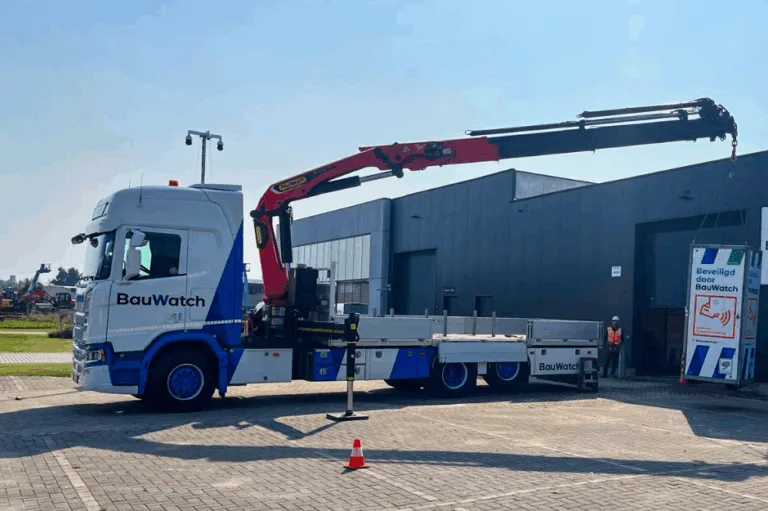In-company opleiding autolaadkraan
Leer werken met een autolaadkraan op de eigen werkvloer
Een autolaadkraan kan worden ingezet voor heel wat verschillende opdrachten: van het laden en lossen van een paar paletten met tegels tot het hijsen van een zware generator of andere waardevolle en fragiele apparatuur.
Daarom is het belangrijk dat de operator van de autolaadkraan exact weet hoe een autolaadkraan veilig ingezet kan worden en wat de limieten zijn van het apparaat.
Tijdens deze opleiding laadkraan zorgt Prevom ervoor dat de deelnemers in de vertrouwde werkomgeving alle inzichten verwerven die nodig zijn om op een veilige en efficiënte manier de opdracht tot een goed einde te brengen. Zo kan de deelnemer dankzij een gebalanceerde mengeling tussen theorie en praktijk zelfzeker en autonoom met de autolaadkraan te werk gaan. Alle belangrijke aspecten komen aan bod om efficiënt en veilig te laden en te lossen.
Onze opleiding gebeurt rechtstreeks op de werkvloer van jouw bedrijf zodat jouw werknemers in een vertrouwde omgeving veilig leren werken met een autolaadkraan.

Duurtijd
De opleiding duurt ongeveer 8 uur
en vindt plaats op één dag in jouw bedrijf.
Deelname-attest
Na de opleiding en interne proef voorzien wij een deelname-attest voor alle geslaagde deelnemers.
Kostprijs
€ 1295 excl. BTW (totaal) en verplaatsingskosten per opleidingsdag voor maximaal 8 deelnemers.
Onze boekingsmethode
Boeken kan zowel via via e-mail of telefoon.
Als je gebruik wil maken van de KMO-portefeuille, vul dan onderstaand formulier in, i.p.v. via ons online platform te gaan.
Indien je meer informatie wenst of ondersteuning nodig hebt kan je ons steeds vlot bereiken!
In-company opleiding
-
Een in-company opleiding voor jouw bedrijf?
-
Vul het onderstaande contactformulier in.
-
We nemen zo snel mogelijk contact met je op.
Prevom: een erkend opleidingscentrum
Wij hechten veel waarde aan de kwaliteit van onze opleidingen. Daarom doen we er alles aan om die hoge kwaliteit te blijven garanderen.
Prevom heeft verschillende kwalificaties en erkenningen behaald dankzij deze proactieve houding.
Meer informatie over al onze erkenningen en opleidingen vind je hier.
Benieuwd naar wat klanten vinden van onze diensten? Klik hier.

Prevom is een erkend dienstverlener in het kader van de KMO-portefeuille.
Dankzij deze erkenning kan uw onderneming gebruik maken van financiële tegemoetkomingen vanuit het KMO-P voor onze opleidingen.
DV.O245622
Prevom is eveneens erkend dienstverlener door WSE (Werk & Sociale Economie) van de Vlaamse overheid. Hierdoor geeft onze opleiding PAIII recht op Vlaams opleidingsverlof. Erkenningsnummer: ODB-1002616
Prevom heeft een succesvolle Qfor-audit doorlopen.
Dit kwaliteitslabel (gericht op opleidingen en consultancy) is indicatief van de kwaliteit van onze opleidingen.
Wij engageren ons op verschillende manieren om de kwaliteit van onze opleidingen te garanderen.
Prevom is een door BeSaCC erkend examencentrum. Dit betekent dat Prevom officieel examens mag afnemen voor persoonlijke VCA certificaten (VCA basis en VCA VOL).
Prevom werkt samen met verschillende organisaties in de bouwsector.
Zo komen onze klanten voor bepaalde relevante opleidingen (zoals de veiligheidsopleiding voor de bouwsector) in aanmerking voor een premie.
Als bediende die tot paritair comité 200 behoort, krijg je financiële ondersteuning van Cevora en kan je een opleidingssubsidie aanvragen.
Alimento groepeert de sectorale diensten die onder beheer van de sociale partners worden aangeboden aan de werknemers en de werkgevers van de voedingsindustrie (PC 118 en PC 220).

Frequent gestelde vragen autolaadkraan opleiding (FAQ)
- Minstens 18 jaar zijn
- Medisch geschikt zijn
- De taal van de opleiding meester zijn
Iedere werknemer die een autolaadkraan moet bedienen.
Er wordt ingezet op zowel de fundamentele kennis van de apparatuur zelf als de bedieningstechniek om goederen te laden en te lossen zonder schade of verlies te veroorzaken.
De opleiding voldoet volledig aan de opgelegde norm – elke student die deze opleiding succesvol doorloopt heeft de nodige kennis en vaardigheid om een autolaadkraan op een uiterst effectieve manier in te zetten.
Deze opleidingen zijn bedoeld voor bedrijven die hun personeel willen opleiden in het veilig bedienen van hun eigen arbeidsmiddel binnen de eigen werkomgeving.
Algemene doelstelling:
Veilig en efficiënt leren werken met de autolaadkraan op de eigen werkvloer van het bedrijf.
Dit houdt in:
- De deelnemer wordt opgeleid om een veiligheidsfunctie te bekleden.
- De deelnemer wordt een efficiënte goederenbehandelaar die preventief defecten/storingen meldt.
- De deelnemer leert ongevallen, letsels en schade aan zowel producten als de werkomgeving te vermijden.
- De deelnemer leert de principes van veilig dynamisch rijgedrag uitgebreid kennen.
Dit kan op verschillende manieren.
Stuur ons een e-mail, bel ons op 03 369 72 73 of contacteer ons via ons contactformulier onderaan.
Hier volgt een zeer gedetailleerd overzicht van de eindtermen van de opleiding op theoretisch vlak.
De inhoud van de opleiding is steeds volledig conform de geldende normen.
De deelnemer autolaadkraan bedienen die slaagt…
- kent de veiligheidsfunctie van de operator van een autolaadkraan.
- weet wat een werkvergunning is en kan deze zowel interpreteren als naleven.
- begrijpt lasttabellen, begrijpt de werking van de lastmomentbegrenzer of andere overbelastingsbeveiligingen.
- kent de verschillende aandrijvingen PTO, elektrohydraulisch, verbrandingsmotor) en hun toepassingsgebied.
- weet welke factoren de belasting & de stabiliteit van de laadkraan en truck beïnvloeden.
- kent het aanslagmateriaal en hijstoebehoren.
- kent de gangbare hijstekens.
- weet hoe een vrachtwagen op een veilige manier te beladen en lichte en zware lasten te stuwen tegen ladingverlies.
- weet hoe men de risico’s aan eigen toestellen en ruimte kan vaststellen, analyseren en controleren.
- kent de wetgeving (basis) voor een bediener van een autolaadkraan: ARAB, Codex, aansprakelijkheden en verantwoordelijkheden, verplichte keuringen van kraan/hulpmiddelen/aanslagmateriaal.
Volgende veiligheidsvoorschriften zijn gekend:
- Nooit boven personen komen met een last.
- Rekening houden met elektrische circuits bij werk op hoogte
- Het observeren van een minimale veiligheidsafstand ten opzichte van hoogspanningslijnen.
- Risico’s in verband met de minimale doorrijhoogte.
- Mogelijke risico’s bij grondwerken en in de buurt van hellingen/taluds.
- Gevaren i.v.m. beklemming van de operator of collega’s.
- De mogelijke risico’s i.v.m. een val bij het opstappen/verlaten.
- Risico’s die voortkomen uit onverharde terreinen en een holle ondergrond bij afstempeling/neerzetten.
- Risico’s voortkomend uit verkeer in de buurt van de werkzaamheden.
- Gevaren die voortvloeien uit het manipuleren van ongebundelde goederen.
- Risico bij/door gebruik van de kraan door onbevoegden.
Volgende begrippen zijn gekend:
- Vaste (vooraan/centraal/achteraan) of verrijdbare constructie
- Snelwisselconstructies.
- Opbouw van de kraanarm.
- De verschillende aandrijfvormen.
- Het centraal smeersysteem.
- Manueel of hydraulisch bediende stempels
- Het aantal stempels.
- Bedieningsmodule (en de elementen hiervan) zoals hydraulische hendels of afstandsbediening.
- (Veiligheids)ventielen.
- Beveiligingen.
Men weet welke individuele beschermingsmiddelen men dient te dragen:
Veiligheidsschoenen, veiligheidshandschoenen, kledij tegen slechte klimatologische omstandigheden, een reflecterend vest bij werken in nabijheid van verkeer, een veiligheidshelm, …
Men weet welke hulpmiddelen er zijn:
Grijpers, pallethaken, klemmen, laadbakken, hijshaken, grondboren, aanslagmateriaal.
Men kent het aanslagmateriaal en aanverwanten:
Kettingen, hijsbanden, en staaldraadstroppen als aanslagmateriaal en onder andere hijsringen, harpsluitingen, D-sluitingen en hoekbeschermers als toebehoren. Men kan deze correct stockeren op de truck en kan deze gericht inzetten om een goede hijs te verwezenlijken (gewichtsbepaling, zwaartepunt vaststellen, hoek/figuur van aanslaan)
De startcontrole is gekend:
- Staat nakijken van slijtplaten, assen, bussen, leidingen.
- Het niveau van de hydraulische olie nakijken.
- Controle op lekken in het systeem.
- Controleren op juiste aansluiting en veilige toestand van de hulpmiddelen.
- Smering van het apparaat nakijken/bijwerken.
- De goede staat van de stempels en bijhorende borgingselementen verifiëren.
- Afstelling van de hydraulische bewegingen.
- Orde en netheid van de bedieningsplaats bewaren.
Daarnaast kent men uiteraard de verkeersreglementering bij gebruik op de openbare weg.
Hier volgt een gedetailleerd overzicht van de eindtermen van de opleiding op praktisch vlak.
De deelnemer die slaagt…
- kent de veiligheidsregels en kan deze toepassen.
- kan veilig en efficiënt werken.
- kan de dagelijkse inspectie uitvoeren (correct herkennen én melden van gevaarlijke defecten).
- weet de PTO of andere aandrijfvorm correct in- of uit te schakelen.
- kan de stabilisatoren veilig afstempelen.
- kan veilig op- en afstappen van de bedieningsplaats en het laadplatform van de autolaadkraan.
- weet de bedieningselementen van de autolaadkraan correct te gebruiken.
- kan de autolaadkraan uit transportpositie brengen zonder negatieve belasting aan het borgingssysteem of de vrachtwagencabine.
- weet lichte en zware lasten veilig aan te slaan met aanslagmateriaal, en weet hoe men de slingerbeweging kan dempen en vermijden.
- kan werken met hijstekens in de praktijk.
- gaat netjes en ordelijk te werk.
De geslaagde deelnemer kan volgende manoeuvres met de autolaadkraan vlot uitvoeren:
- Een last opnemen met de laadkraan van op een grondvlak.
- Pallets naast elkaar plaatsen voor- en achteraan op de laadruimte.
- Pallets neerzetten op een gecontroleerde en zachte wijze met een pallethaak (met een maximale speling van 20 cm).
- Lasten correct en veilig op elkaar stapelen op grondniveau.
- Een lange last opnemen met aanslagmateriaal van op een grondvlak en vervolgens neerplaatsen in de laadruimte op een beperkte plaats (met maximum 40 cm speling).
- Een last omdraaien zonder brutale/onstabiele bewegingen met de laadkraan.
- Afstanden en diepte accuraat inschatten.
- De autolaadkraan terug in een veilige transportpositie brengen.
Aangezien de opleiding werken met autolaadkraan en het examen in jouw bedrijf plaatsvinden wordt er steeds verwacht dat de klant het nodige materiaal voorziet.
In het geval van deze cursus betreft dit een (vracht)wagen met autolaadkraan in onderhouden en gekeurde toestand.
Op deze manier moet er geen materiaal ter plaatse gebracht worden, wordt er geen borg betaald én leert de student ineens veilig werken met het specifieke type van autolaadkraan dat de werkgever gebruikt.
De locatie voor deze cursus dient steeds door de klant te worden voorzien.
Dit heeft meerdere voordelen, met name het feit dat deelnemers efficiënt leren werken met de autolaadkraan op de eigen werkvloer.
Dat betekent niet alleen minder zenuwen dankzij de vertrouwde omgeving, maar ook een verbeterd praktijkinzicht!
De opleiding duurt 1 dag. Er is plaats voor maximaal 8 ervaren of 5 niet-ervaren deelnemers per sessie.
Het examen heeft twee delen: praktijk en theorie.
Het theoretisch examen duurt ongeveer 30 minuten.
Het praktijkexamen duurt minimum 30 minuten.
Elke deelnemer die slaagt voor beide examens krijgt een certificaat. Dit certificaat is 5 jaar geldig. Na deze periode van 5 jaar is het de verantwoordelijkheid van de werkgever om een nieuwe opleiding of opfrissing te in te plannen. Na deze opleiding kan de deelnemer opnieuw geattesteerd worden.
Bij het niet slagen van een deelnemer wordt de verantwoordelijke van het bedrijf gecontacteerd en wordt er in samenspraak met het bedrijf naar een oplossing gezocht.
Je ontvangt een deelname-attest van Prevom. Op dit attest staat dat je de opleiding succesvol hebt voltooid.
De wetgever verwacht van de werkgever dat de werknemers aantoonbaar opgeleid zijn en bevoegd worden verklaard om machines te besturen. Daarnaast biedt deze opleiding ook de mogelijkheid om jouw competenties aan te scherpen.
Prevom adviseert een herbeoordeling van de competenties van de medewerkers binnen de 5 jaar na uitgiftedatum van het attest.
Als je jouw attest bent kwijtgeraakt, bespreek je dit best met je werkgever. Zij kunnen vervolgens contact opnemen met Prevom.
Wij rekenen €30 administratieve kost aan om een nieuw attest op te maken.
Nee, onze autolaadkraan opleidingen zijn exclusief voor bedrijven en worden in-company georganiseerd.
Wij bieden graag een oplossing op maat van jouw bedrijf.
Onze experts verplaatsen zich overal in Vlaanderen om jouw personeel een kwalitatieve opleiding te geven.
Prevom is een erkend dienstverlener in het kader van de KMO-portefeuille: DV.O245622
Dankzij deze erkenning kan jouw onderneming gebruik maken van financiële tegemoetkomingen vanuit het KMO-P voor onze opleidingen.
Als je hiervan gebruik wil maken, vul dan onderstaand formulier in, in plaats van ons online platform te gebruiken, en duid aan dat je de KMO-portefeuille wil gebruiken. Dan zorgen wij voor de rest.
Prevom hanteert een eerlijk en transparant beleid voor haar opleidingen – er zijn dus geen verborgen of bijkomende kosten.
Zowel professionele als particuliere klanten ontvangen steeds een geldige BTW factuur.
Indien de klant niet opdaagt (no-show) of een annulering doorvoert, blijft de inschrijvingskost of het factuurbedrag volledig verschuldigd. Hetzelfde geldt wanneer de klant verzoekt om de afspraakdatum te verplaatsen binnen een termijn van twee weken voorafgaand aan de geplande afspraak. De klant heeft het recht om de opleiding éénmalig kosteloos te verplaatsen, op voorwaarde dat dit verzoek minstens twee weken vóór de geplande datum wordt ingediend.
Als u niet deelneemt aan het examen of opleiding, kan u eveneens géén certificaat/attest bekomen. Om een certificaat/attest te bekomen moet u uiteraard slagen voor het examen/interne proef.
Wij proberen er uiteraard voor te zorgen dat er nooit een examen- of opleidingsmoment door Prevom moet worden geannuleerd. Mocht dit door uitzonderlijke redenen of extreme omstandigheden toch gebeuren, dan wordt u hier telefonisch of via mail van op de hoogte gesteld.
Het inschrijvingsgeld wordt in geval van annulatie door Prevom volledig terugbetaald, zonder enige bijkomende vergoeding bovenop het initieel bedrag dat u betaalde bij jouw boeking.
Als op de dag van de opleiding blijkt dat de praktijk niet op een veilige manier kan uitgevoerd worden, behouden wij het recht op de opleiding te staken zonder terugbetaling van het verschuldigde bedrag.

Plan jouw opleiding
Prevom organiseert de perfecte in-company opleiding autolaadkraan voor jouw onderneming.
Neem contact met ons op om de mogelijkheden voor jouw bedrijf te bespreken en een offerte op maat te ontvangen.
